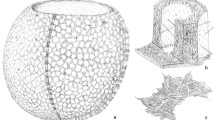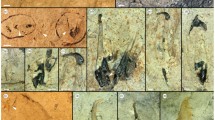Abstract
A fossil organism, Palaeophragmodictya Gehling et Rigby, 1996, previously classified within sponges, is found for the first time in the Vendian of the Arkhangelsk Region. Based on the new finds, Palaeophragmodictya is interpreted as an attachment disc of a problematic animal with combined coelenterate and sponge morphology. Typical and unique preservational forms from the same bedding plane are described. Three-dimensional fossils are preserved as flat impressions at random horizontal levels. Bilateral symmetry discovered in the ontogeny of Palaeophragmodictya spinosa sp. nov. supports the hypothesis of initial bilaterality of Cnidaria.
Similar content being viewed by others
References
V. N. Beklemishev, Fundamentals of Invertebrate Comparative Anatomy, Vol. 1. Promorphology (Nauka, Moscow, 1964) [in Russian].
E. Billings, “Fossils in Huronian Rocks,” Canad. Natur. Quart. J. Sci., No. 6, 1–478 (1872).
M. Brasier, O. Green, and G. Shields, “Ediacarian Sponge Spicule Clusters from Southwestern Mongolia and the Origins of the Cambrian Fauna,” Geology 25, 303–306 (1997).
M. E. Clapham, G. M. Narbonne, J. G. Gehling, et al., “Thectardis avalonensis: A New Ediacaran Fossil from the Mistaken Point Biota, Newfoundland,” J. Paleontol., No. 78, 1031–1036 (2004).
M. A. Fedonkin, “Promorphology of Vendian Radialia,” in Stratigraphy and Paleontology of the Earliest Phanerozoic (Nauka, Moscow, 1984), pp. 30–58 [in Russian].
J. G. Gehling, “Microbial Mats in Terminal Proterozoic Siliciclastics: Ediacaran Death Masks,” Palaios 14(1), 40–57 (1999).
J. G. Gehling, G. M. Narbonne, and M. M. Anderson, “The First Named Ediacaran Body Fossil, Aspidella terranovica,” Palaeontology 43(3), 427–456 (2000).
J. G. Gehling and J. K. Rigby, “Long Expected Sponges from the Neoproterozoic Ediacara Fauna of South Australia,” J. Paleontol. 70(2), 185–195 (1996).
M. F. Glaessner, The Dawn of Animal Life: A Biohistorical Study (Cambridge Univ. Press, Cambridge, 1984).
M. F. Glaessner and M. Wade, “The Late Precambrian Fossils from Ediacara, South Australia,” Palaeontology 9, 599–628 (1966).
D. V. Grazhdankin, “Structure and Sedimentation Conditions of the Vendian Complex of the Southeastern While Sea Region,” Stratigr. Geol. Korrelyatsiya 11(4), 313–331 (2003).
T. M. Harris, “The Fossil Flora of Scoresby Sound, East Greenland: Description of Seed Plants Incertae Sedis, Together with a Discussion of Certain Cycadophyte Cuticles,” Medd. Grønland 85(5), 1–133 (1932).
H. J. Hofmann, “Precambrian Fossils, Pseudofossils, and Problematica in Canada,” Bull. Geol. Surv. Can., No. 189, 1–146 (1971).
A. Yu. Ivantsov, “New Proarticulata from the Vendian of Arkhangelsk Region,” Paleontol. Zh., No. 3, 21–26 (2004) [Paleontol. J. 38, 247–253 (2004)].
A. Yu. Ivantsov, Ya. I. Malakhovskaya, and E. A. Serezhnikova, “Nekotorye problematiki iz vendskikh otlozhenii Yugo-Vostochnogo Belomor’ya,” Paleontol. Zh., No. 1, 3–9 (2004) [Paleontol. J. 38, 1–9 (2004)].
C.-W. Li, J.-Y. Chen, and T.-E. Hua, “Precambrian Sponges with Cellular Structures,” Science 279(5352), 879–882 (1998).
V. V. Malakhov, “New Concept of the Origin of Bilateral Symmetrical Animals,” Biol. Morya 30(5), 335–346 (2004).
E. A. Serezhnikova, “Vendian Ediacaria from the Zimnii Bereg Locality of the White Sea: New Records and New Reconstructions,” Paleontol. Zh., No. 4, 46–55 (2005) [Paleontol. J. 39, 386–394 (2005)].
R. C. Sprigg, “Early Cambrian? Jellyfishes of Ediacara, South Australia, and Mount John, Kimberley District, Western Australia,” Trans. Roy. Soc. South Australia, No. 73, 72–79 (1949).
Author information
Authors and Affiliations
Additional information
Original Russian Text © E.A. Serezhnikova, 2007, published in Paleontologicheskii Zhurnal, 2007, No. 4, pp. 16–24.
Rights and permissions
About this article
Cite this article
Serezhnikova, E.A. Palaeophragmodictya spinosa sp. nov., a bilateral benthic organism from the Vendian of the Southeastern White Sea Region. Paleontol. J. 41, 360–369 (2007). https://doi.org/10.1134/S0031030107040028
Received:
Issue Date:
DOI: https://doi.org/10.1134/S0031030107040028




